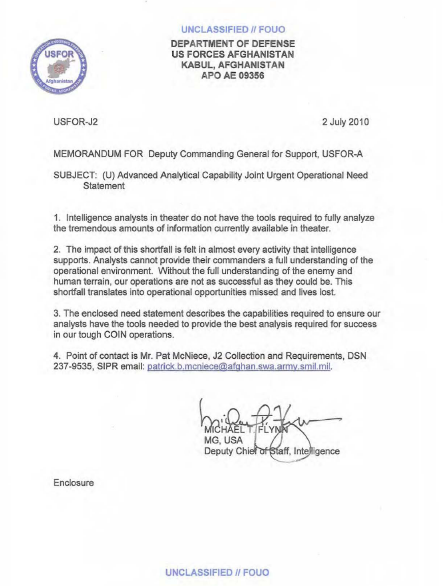This “Urgent Operational Need Statement”, originally obtained and published by Politico, was written by Major General Michael T. Flynn in response to severe problems experienced by intelligence analysts when using the Army’s $2.7 billion Distributed Common Ground System. According to the statement, the failures of the system make operations less successful and translate into “lives lost”.
 Advanced Analytical Capability Joint Urgent Operational Need Statement
Advanced Analytical Capability Joint Urgent Operational Need Statement
- 6 pages
- For Official Use Only
- July 5, 2010
SUBJECT: (U) Advanced Analytical Capability Joint Urgent Operational Need Statement
1. Intelligence analysts in theater do not have the tools required to fully analyze the tremendous amounts of information currently available in theater.
2. The impact of this shortfall is felt in almost every activity that intelligence supports. Analysts cannot provide their commanders a full understanding of the operational environment. Without the full understanding of the enemy and human terrain, our operations are not as successful as they could be. This shortfall translates into operational opportunities missed and lives lost.
3. The enclosed need statement describes the capabilities required to ensure our analysts have the tools needed to provide the best analysis required for success in our tough COIN operations.
…
(U//FOUO) General Description: US intelligence analysts in Afghanistan have several tools available to access the ever-increasing amount of intelligence and battlefield information residing in a myriad of databases. These tools provide access to the information, some more readily than others, but provide little in the way of improved analytical support. Advanced analytical tools are critical for providing the required intelligence support to population-centric operations.
Current tools do not provide intuitive capabilities to see the relationships between a wide variety of disparate sets of information. They do not allow easy viewing of the information in multiple formats such as link diagram, geo-spatial, histogram, timeline, time wheel and data reports. They do not provide significant network-wide collaborative capabilities. They do not provide the ability to support low-bandwidth or frequently disconnected users with a data sub-set tailored to their area of operations.
There is a critical need to enable analysts in theater with these capabilities to provide our commanders a better understanding of the complex COl N environment in which they operate. Solving these data manipulation, visualization and understanding requirements will significantly improve our ability to successfully conduct population-centric operations.
(U//FOUO) Mission and Threat Analysis: Counterinsurgency operations are among the most complex, especially in the Afghan environment. USFOR-A has been challenged in this environment to fully understand the multi-faceted situation. The enemy is able to take advantage of his ability to hide in plain sight in the population because we have been unable to fully exploit the information/intelligence we already have. Detainees with existing connections to the insurgency have been released because we could not fully understand or exploit the information we held. Negative influencers are able to continue hindering progress because we are unable to fully understand their methods and connections. Conversely, we don’t know how many opportunities to positively influence events have been lost due to our failure to maximize our understanding of the environment.
(U//FOUO) Structuring and Organization of Capabilities: This JUON is a request for a theater-wide web-based advanced analytical platform to store, organize, access, retrieve and enable full understanding of intelligence and information from multiple large disparate data sets. We require this capability on three networks: a small capability on JWICS and larger-scale installations for SIPR and the CENTRIXS-ISAF Network (CXI). The SIPR network should support SIPR REL for ACGU users. The capability should provide a client-server architecture wherein users at headquarters or high-bandwidth locations access a regional server using their existing workstation. Low-bandwidth or frequently disconnected users should be provided a laptop capable of maintaining the data and applications.
